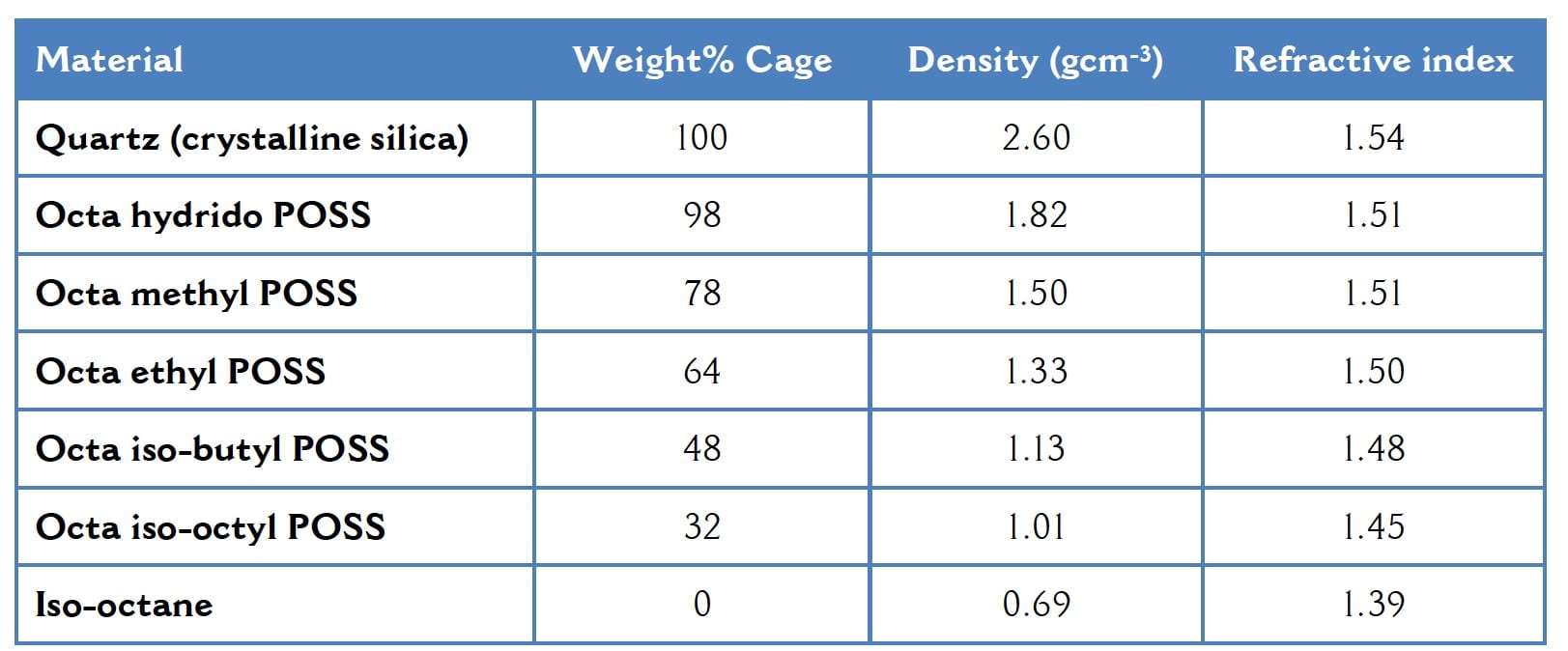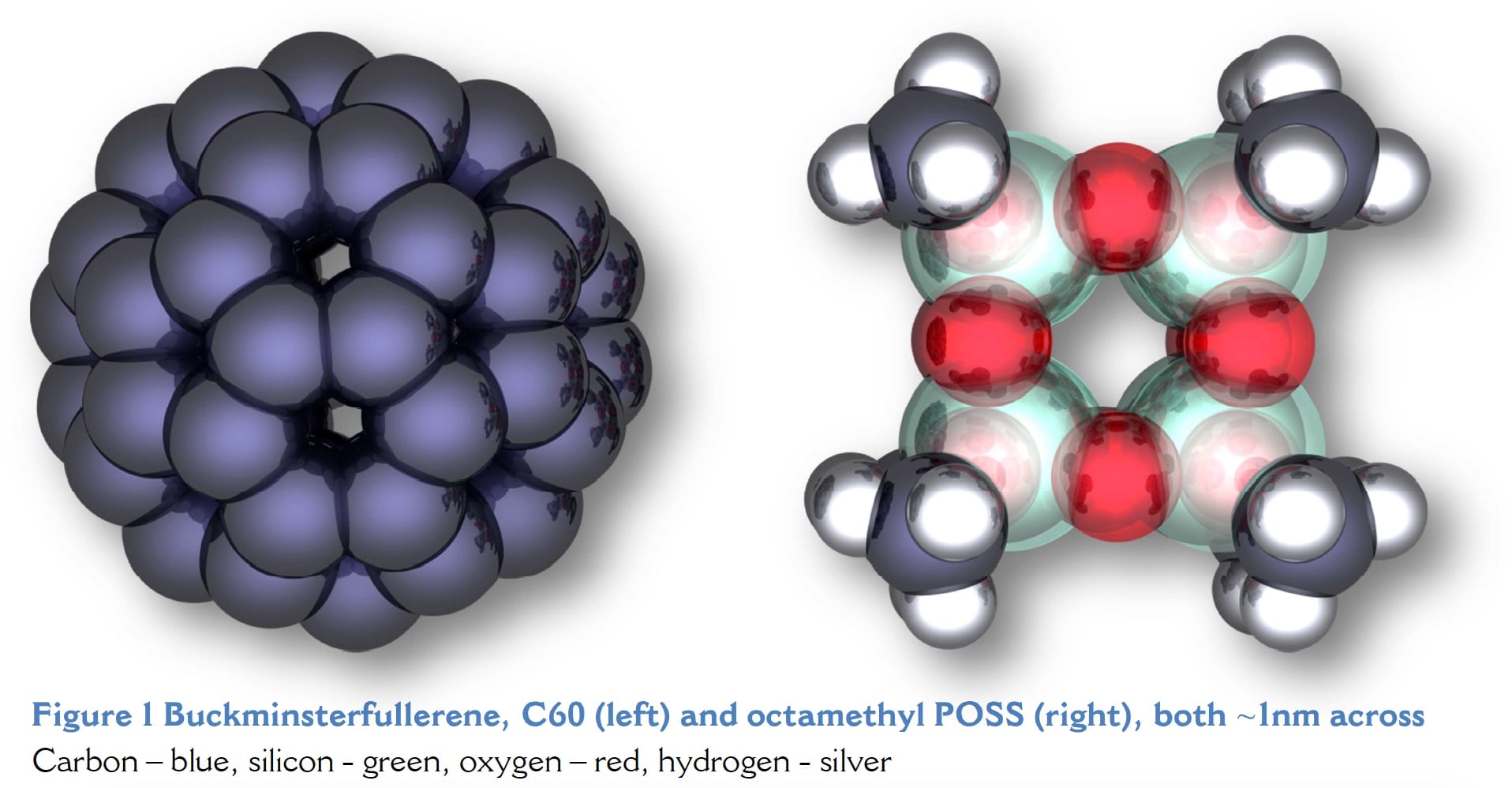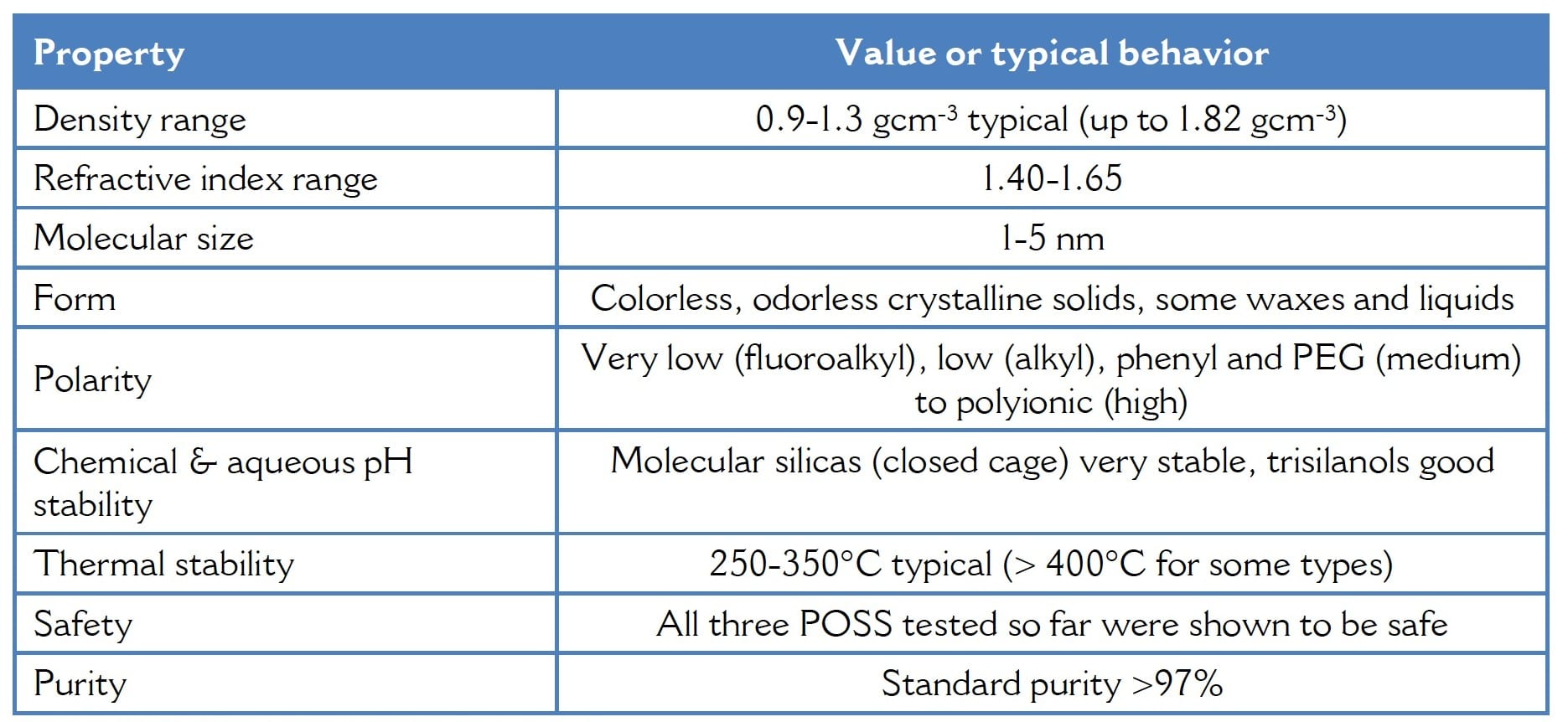Polyhedral Oligomeric Silsesquioxanes
Introduction
Polyhedral oligomeric silsesquioxanes, often abbreviated POSS®, PSS or POS, are hydrid materials composed of an inner, rigid, silica cage structure surrounded by more flexible organic groups. The organic groups can be selected to impart solubility of the POSS molecule and to tune the properties. Visually, the POSS molecule looks like filler particles and many consider it to be a kind of molecular filler or the smallest possible silica particle. Here is a 3D ray traced video animation I made of octaisobutyl POSS using POV-Ray. Yes, it was tedious, but I think the results speak for themselves.
Properties
During my time as Chief Scientist for Hybrid Plastics Inc., I sensed the need for a document on POSS and its application in plastics. After all, when you have an unusual additive, people have to know what it is and what it can do, before they can try it then buy it. Thus, the POSS User’s Guide was born. The effort I put into writing that document was well rewarded as the number of downloads soon reached 700 per month and has remained steady since 2007. Later I wrote the POSS Handbook as an impartial source of information, written by someone very familiar with POSS but who no longer has any commercial connection to POSS. Some of the content is borrowed from that document.

The table shows the hybrid nature of POSS. Types at the top with a high cage content are rigid like silica whereas adding large organic groups give properties more akin to conventional molecules. Those types with very large, flexible groups like PEG POSS are liquids. POSS is reminiscent of Buckminsterfullerene (C60) as both are spherical cage molecules. Octamethyl POSS and C60 are show below to the same scale. C60 has attracted enormous attention and a Nobel Prize. Another similar family of molecules are the diamondoids which were researched by Chevron some years ago.

Before we move on to look at potential applications for POSS, it is first essential to look at the properties because applications stem from properties.

Applications
There are many effects that can be achieved with POSS. The ones that will take off are the ones for which POSS is better and / or cheaper than other alternatives. Scientists often look at the effect alone without regard for commercial factors, which is not surprising, because that is not their concern. Here I list some of the applications, several of which I helped develop then assess which ones appear to make commercial sense. More details can be found in the POSS Handbook.
Initially it was thought that POSS could be used to reinforce plastics but that turned out not to be the case. Modulus and strength are not much affected at all. Much later, fluoro POSS was used to make surface very hydrophobic but the same feat can be accomplished at much lower cost using other fluorinated molecules.
POSS flow aids
Small molecules lubricate polymer chains and promote flow. However, they are often thermally unstable and normally they plasticize the polymer, that is modulus and strength both suffer. POSS has proven useful for enhancing flow of high temperature polymers like PEEK, PEI and PPS because of its high thermal stability and the rigid nature of the cage. The rigid POSS molecule does not plasticize so mechanical performance is maintained. This was something I helped develop and we were proud to receive the R&D 100 Award for the product range.
Colorless polyimide
Polyimide is normally transparent but has a distinct orange color. By copolymerizing with POSS, the color is removed, thus paving the way for new optical applications. This has been patented and commercialized.
POSS dental restoratives
Dental materials are sold in small amounts and at high prices. Dental glass filler can cost up to $1000 per pound for example. Small amounts of POSS are used in these applications. It is claimed that the POSS molecules are exactly the right size to plug nanotubules in the tooth to prevent sensitivity.
POSS lubricants
The US Air Force looked at some POSS types as potential lubricants but results were disappointing. Years later I led a drive to make and commercialize PEG POSS, a liquid, in bulk. We made it in just 4 weeks and it turned out to be a top selling product. When tested on industry standard equipment, it was found to perform better than the best in class lubricant on the market. Although the PEG POSS is significantly more expensive, it may be that there are niche applications where lubricant performance is paramount and cost is secondary. The other application we targeted was cosmetics and that turned out to be a significant application for PEG POSS.
POSS dispersants
It was been shown that POSS trisilanols, which have one corner of the cage missing to expose highly reactive Si-OH groups, are very effective dispersants, even for particles for which conventional organosilanes do not work. It may be that there are applications, for example in dental materials, where these POSS dispersants would be suitable.
Commercial aspects
Unusual molecules always attract attention from the scientific community but they only become important when they can compete in the real world on availability, price and performance.

In many ways POSS is more attractive than other high profile technologies although still significantly more costly than most plastics additives. The starting material cost for POSS is fixed and rather high so there is a floor on the price of POSS even if it is scaled up.
Conclusion
As we have seen, the POSS family of molecules is interesting and has been the focus of a great deal of research. One or two very niche applications exist already and it can be expected that new applications will gradually be found over the coming decades. Unfortunately, the commercial potential of POSS very much limited in three ways. Firstly, the high cost, which cannot be further lowered because the raw materials used to make POSS are themselves expensive ($10-20 / lb) in bulk for the least expensive types. Secondly, as discussed, the marketing efforts have been focused on applications that make no sense in terms of cost or performance. Lastly, commercial exploitation of new technologies takes in the order of 10-20 years. Based on that last comment we can expect to see applications take off soon.
Need help with POSS?
Further reading
Polyhedral Oligomeric Silsequioxane (POSS) Enhanced Plastics (Chapter 23)
C. DeArmitt, Functional Fillers for Plastics, 2nd Edition, Editor Professor M. Xanthos, Wiley-VCH, 2010.
Polyhedral Oligomeric Silsesquioxanes in Plastics (Chapter 5)
C. DeArmitt, Applications of Polyhedral Oligomeric Silsesquioxanes, Editor C. Hartman-Thompson, Springer Press, 2011.
POSS Handbook
C. DeArmitt (properties and applications of polyhedral oligomericsilsesquioxanes).
POSS User’s Guide
C. DeArmitt POSS User’s Guide 700 downloads per month since 2007.
POSS keeps high temperature plastics flowing
C. DeArmitt & P. Wheeler, Plastics Additives & Compounding (Elsevier), 10, 4, 36-39 (2008).
Polyhedral Oligomericsilsequioxanes: Additives for Unique Cosmetic Properties
C. DeArmitt Cosmetics & Toiletries (Allured Publishing), 123, 8, 51-56 (2008).
POSS® is a registered trademark of Hybrid Plastics Inc.